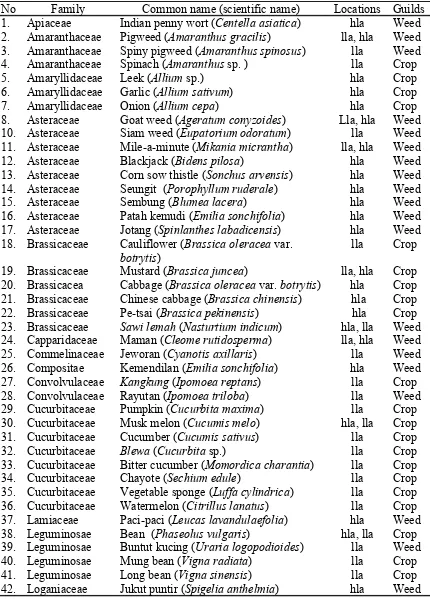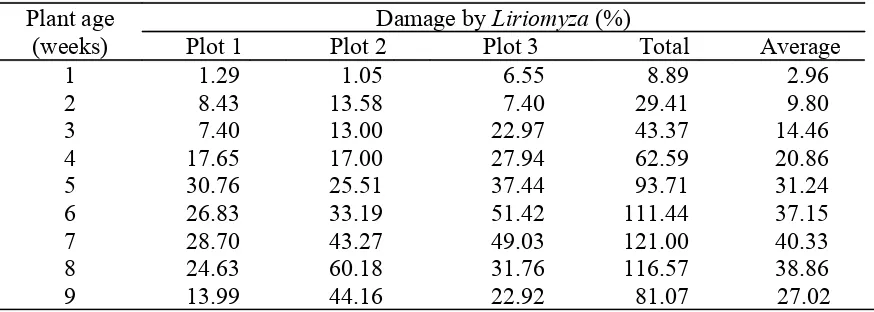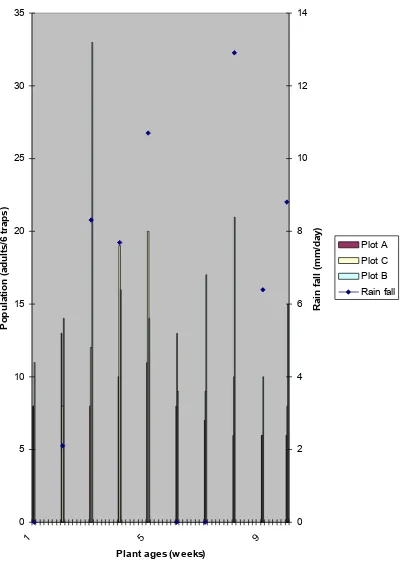ECOLOGY OF
Liriomyza
spp.
(DIPTERA: AGROMYZIDAE)
IN FIELD VEGETABLES IN SOUTH SUMATERA
SITI HERLINDA
Plant Pest and Disease Department, Faculty of Agriculture, and Crop Science Program, Graduate Program, Sriwijaya University, Jl. Raya Palembang-Prabumulih, Km 32, Inderalaya, Ogan Komering Ilir 30662, Phone (62)0711-580059, Fax. (62)0711-580276, Email: [email protected]
ABSTRACT
Surveys during January up to June 2003 were conducted to record host species of Liriomyza leaf miner, to determine the leafminer damage, to detect adult population of this leaf miner, and to identify the leafminer parasitoid species. Leafminer-infested leaves of host plants were collected every three weeks for determining the parasitoid species. This leafminer-infested leaves were also used to identify species of Liriomyza host plants. Leafminer adult population and damage on tomato leaves were recorded weekly. The population was monitored with yellow sticky traps. The result showed that a total of 53 species of plants could be infested by the leafminer. Foliage damage caused by leaf miner activity of Liriomyza larvae caused linear, irregular (serpentine), whitish or greenish mines. Heavily damaged crops appeared as if they had been scorched by fire. Throughout tomato growing season, level of foliage damage caused by the leafminer reached 40.33%. The adult population was associated with crop phenology and weather condition. Number of adults trapped increased with the increasing the crop age. The population during rainy days was generally low. We found six species of hymenopteran parasitoids associated with Liriomyza. The parasitoids found including Hemiptarsenus varicornis, Quadrasticus sp., Opius sp., Neochrysocharis sp., Granotoma sp., and one unknown species of Eulophidae. The most common parasitoid found was H. varicornis. The parasitism by this parasitoid reached 9.76% on cabbage field at Pagar Alam.
Keywords: Host plant species, damage, population, parasitoids, Liriomyza spp., and vegetable crops
INTRODUCTION
Field vegetable growing worldwide is under siege from three Liriomyza spp. (Diptera: Agromyzidae) leafmining flies, Liriomyza sativae (Blanchard), Liriomyza trifolii (Burgess), and Liriomyza huidobrensis (Blanchard). The damage caused by these
reported to have caused up to 70% yield losses in potato, beans, and tomato in some areas of Indonesia (Shepard et al., 1998).
Control of agromyzid leafminers using sinthetic and natural insecticides has been extensively researched and commonly used by smallholder farmers (Rauf & Shepard, 2001). In Indonesia, especially in South Sumatera, farmers attempt to control these pests throught the frequent applications of the insecticides. They always treat as often as twice a week. However, the farmers were not satified with the efficacy of these controls. The insecticides were unable to kill the larvae within leaf tissues. Insecticide resistance by these leafminers has been well documented (Smith 1986; Rathma et al., 1995). Other control techniques being optimum for leafminer have to be developed. Biological control for the leafminer has been reported to be effective (Rauf et al., 2000; Rauf & Shepard, 2001). The biological control is an important keystone of integrated pest management (IPM).
Basic information on the ecology of Liriomyza is necessary for integrated management of this pest. That information in field vegetable crops in South Sumatera. is lacking. Thus, this research was conducted to record host species of Liriomyza leaf miner, to determine the leafminer damage, to detect adult population of this leaf miner, and to identify the leafminer parasitoid species.
MATERIALS AND METHODS
Surveys were conducted from January until May 2003 at Inderalaya and Pagar Alam in District of South Sumatera. At Inderalaya, the temperature and relative humidity during surveys were 26.5o C and 85.5%, respectively. At Pagar Alam, the temperature
was 25o C. Rainfall was 7.8 mm/day at Inderalaya and 12 mm/day at Pagar Alam. The
elevation at Inderalaya is 5 m above sea level (asl), and 900 m asl at Pagar Alam.
Host Plant Species and Damage by
Liriomyza spp.
This Liriomyza damage was recorded in the field tomato plot (2,400 m2) in
Inderalaya. The plot was divided into 3 subplot (800 m2). From the subplot, we took 10 %
of plant population to determine the damage of Liriomyza. Determination of damage by Liriomyza i.e. 0 = no damage; 1 = > 0 damage ≥ 25%; 2 = > 25 damage ≥ 50%; 3 = > 50 damage ≥ 75%; dan 4 = >75 damage ≥ 100%. The symptoms of foliage damage were also recorded and documented.
Data Analysis. The level of foliage damage were tabulated.
Liriomyza
Population and Its Parasitoids
Method. This Liriomyza population was monitored in field tomato plot (2,400 m2)
in Inderalaya. The plot was divided into 3 subplot (800 m2). The population was
monitored using yellow sticky traps writing after Robin & Mitchell (1985). The sticky traps were ca. 19,5 by 14 cm2 with sticky material on trap surface ca. 144 cm2. The traps
were placed within the subplot in field tomato. The population was monitored with 6 traps per subplot. The traps placed at 50 cm above ground for 3 x 24 hours. The population monitored from a week until 10 weeks after transplanting.
The parasitoids of larval Liriomyza were recorded by sampling larval infested leaves of the tomato, cabbage, mustard, other vegetables, and weeds every three weeks (at 3, 6, 9 weeks after transplanting) in Inderalaya and Pagar Alam. We sampled 300-400 Liriomyza larvae. The infested leaves were examined for the parasitoids emerging every
day at Laboratory of Plant Pests, Plant Pest and Disease Department, Faculty of Agriculture, Sriwijaya University. The leaves from different host plants and locations kept in the different plastic containers (15 cm diameter, 20 cm height). The parasitoids emerged were recorded daily. The parasitoids founded were identified in species or genus. Then, the parasitoid kept in vials containing 70 % alcohol.
Data Analysis. The parasitoid species of leaf miner larvae and the rates of the parasitoid parasitism on the larvae were tabulated.
RESULTS AND DISCUSSION Host Plant Species of
Liriomyza spp.
Liriomyza is a highly polyphagous insect that infests a large number of vegetable
Table 1. Host plant species of Liriomyza at lowland and highland areas in South Sumatera District
No Family Common name (scientific name) Locations Guilds 1. Apiaceae Indian penny wort (Centella asiatica) hla Weed 2. Amaranthaceae Pigweed (Amaranthus gracilis) lla, hla Weed 3. Amaranthaceae Spiny pigweed (Amaranthus spinosus) lla Weed 4. Amaranthaceae Spinach (Amaranthus sp. ) lla Crop
5. Amaryllidaceae Leek (Allium sp.) hla Crop
6. Amaryllidaceae Garlic (Allium sativum) hla Crop
7. Amaryllidaceae Onion (Allium cepa) hla Crop
8. Asteraceae Goat weed (Ageratum conyzoides) Lla, hla Weed 10. Asteraceae Siam weed (Eupatorium odoratum) lla Weed 11. Asteraceae Mile-a-minute (Mikania micrantha) lla, hla Weed 12. Asteraceae Blackjack (Bidens pilosa) hla Weed 13. Asteraceae Corn sow thistle (Sonchus arvensis) hla Weed 14. Asteraceae Seungit (Porophyllum ruderale) hla Weed
15. Asteraceae Sembung (Blumea lacera) hla Weed
16. Asteraceae Patah kemudi (Emilia sonchifolia) hla Weed 17. Asteraceae Jotang (Spinlanthes labadicensis) hla Weed 18. Brassicaceae Cauliflower (Brassica oleracea var.
botrytis)
lla Crop
Table 1. Continued
No Family Common name (Scientific name) Locations Guilds 43. Passifloraceae Permot (Passiflora foelida) lla Weed 44. Portulaceae Krokot (Portulaca oleraceae) lla Weed 45. Rubiacaea Letah ayam (Borreria alata) hla Weed 46. Scrophulariaceae Sesamun (Artanema longifolium) hla Weed 47. Solanaceae Eggplant (Solanum melongena) hla, lla Crop 48. Solanaceae Tomato (Lycopersicum esculentum) hla Crop 49. Solanaceae Current tomato (Lycopersicum
pimpeneliifolium)
lla Crop 50. Solanaceae Potato (Solanum tuberosum) hla Crop 51. Solanaceae Ciplukan (Physalis angulata) lla, hla Weed 52. Umbelliferae Carrot (Daucus carota) hla Crop 53 Umbelliferae Celery (Apium graveolens) hla Crop
lla = Lowland area hla = Highland area
Crops attacked were 27 species mainly in the families of Cucurbitaceae, Leguminosae, Brassicaceae, Solanaceae, Umbellifeae, Amaranthaceae, and Amaryllidaceae. We also recorded 26 species of weeds infested by this leafminer (Table 1). Vegetables crops known as hosts in South Sumatera included tomato, leek, garlic, spinach, onion, cabbage, cauliflower, mustard, cucumber, etc. (Table 1). The species of Liriomyza host plants will increase if survey areas are broadened at ornamental field. However, we limited the survey only on the center of vegetable crops. In Hawaii, this pest was reported by Mau & Kessing (1991) attacked more than 30 species of crops including in the families of Cucurbitaceae, Solanaceae, and Brassicaceae.
Damage by
Liriomyza on tomato
Table 2. Damage by Liriomyza on the tomato leaves at Inderalaya
Plant age Damage by Liriomyza (%)
(weeks) Plot 1 Plot 2 Plot 3 Total Average
1 1.29 1.05 6.55 8.89 2.96
Table 3. Vertical distribution of Liriomyza damage on tomato leaves according to three different strata of canopy
The level of Liriomyza infestation was associated with crop phenology. Infestation of Liriomyza occurred from the beginning of tomato growing season (1 week) until the tomato nearing to be harvested (9 weeks). Infestation on tomato increased slowly during vegetative growth (1-3 week tomato), but it increased rapidly during reproductive one (4-7 week tomato). The heaviest infestation occurred at a 7-week tomato (40.33%) (Table 2), but the infestation decreased when the tomato faced to be harvested (8 and 9-week tomatoes).
The larger damage on the middle and lower strata could be affected by larger larvae mined those leaves. Capinera (2001) found that the middle and lower strata of tomato leaves were the most important site of Liriomyza oviposition, because the leaves of these strata had bigger and thicker leaflets, thus assuring that the larvae had better and more abundant food and space to grow. The adult and larvae of Liriomyza were more abundant on the middle and lower strata. This information is useful in conducting both efficient sampling plans and pesticide application on tomato.
Population of
Liriomyza
The adult population of Liriomyza was monitored with yellow sticky traps. The adult population fluctuated, and was associated with crop phenology and weather condition. More flies were captured at the young tomato (4-week tomato). Number of flies trapped decreased with the increasing crop ages. The adult population during rainy days was generally lower than during daylight hours (Figure 1). The rainy days could limit the fly activities of Liriomyza adults. Issae & Morcano (1991) reported that fly activities of this Liriomyza were more intensive at vegetative growth of tomato than at generative one.
Community Composition of
Liriomyza Parasitoid
We found six species of hymenopteran parasitoids associated with Liriomyza larvae on vegetable crops (tomato and cabbage). The parasitoids found including Hemiptarsenus varicornis, Quadrasticus sp., Opius sp., Neochrysocharis sp., Granotoma
sp., and one unknown species of Eulophidae (Table 4 and 5). Saleh & Herlinda (2002) found 9 species of parasitoids attacking Liriomyza larvae at weed and crop fields in South Sumatera.
0
Table 4. Parasitism by larval parasitoids of Liriomyza on tomato field
Location Time of Crops Parasitism (%) by:
survey H. varicornis Quadrasticus Neochrysocharis sp Unknown
Inderalaya Feb 10, 2003 Tomato 6.25 2.25 4.00 2.00
Feb 27, 2003 Tomato 2.75 0.25 3.75 1.00
Mar 24, 2003 Tomato 2.67 0.33 1.67 2.00
Total 11.67 2.83 9.42 5.00
Avarage 3.89 0.94 3.14 1.67
Table 5. Parasitism by larval parasitoids of Liriomyza on cabbage field
Location Time of Crops Parasitism (%) by:
survey H. varicornis Quadrasticus Granotoma Opius sp.
Pagar Alam Mar 19, 2003 Cabbage 6.45 - 3.22
-Apr 9, 2003 Cabbage 7.69 - 2.56 2.56
Apr 23, 2003 Cabbage 9.76 2.43 -
-May 7, 2003 Cabbage 8.33 - 4.17
-May 21, 2003 Cabbage 9.09 - -
-Total 41.3 2.43 9.96 2.56
Avarage 8.26 2.43 3.32 2.56
In Conclusion
A total of 53 species of plants could be infested by the leafminer, Liriomyza. Foliage damage caused by leaf miner activity of Liriomyza larvae caused linear, irregular (serpentine), whitish or greenish mines. Heavily damaged crops appeared as if they had been scorched by fire. Throughout tomato growing season, level of foliage damage caused by the leafminer reached 40.33%. The adult population was associated with crop phenology and weather condition. Number of adults trapped increased with the increasing the crop age. The population during rainy days was generally low. We found six species of hymenopteran parasitoids associated with Liriomyza. The parasitoids found including Hemiptarsenus varicornis, Quadrasticus sp., Opius sp., Neochrysocharis sp., Granotoma
sp., and one unknown species of Eulophidae. The most common parasitoid found was H. varicornis. The parasitism by this parasitoid reached 9.76% on cabbage field at Pagar
Alam.
ACKNOWLEDGEMENTS
REFERENCE
Capinera J.L. 2001. Vegetable leafminer, Liriomyza sativae. (http://creatures.ifas.ufl.edu/veg/leaf/vegetable_leafminer.htm)
Issae, S & R. Morcano. 1991. Spatial and vertical distribution of L. sativae Blanchard (Diptera : Agromyzidae on Tomato. Bol. Entomol. Venez. N.S. 8(2): 115-122 Johnson, M.W., S.C. Welter, N.C. Toscano, I.P. Ting, & J.T. Trumble. 1983. Reduction
of tomato leaflet photosynthesis rates by mining activity of Liriomyza sativae (Diptera: Agromyzidae). Journal of Economic Entomology 76:1061-1063.
Mau, R.F.L. & J.L.M. Kessing. 2002. Liriomyza sativae (Blanchard) vegetable leafminer. (http://www.extento.hawaii.edu/kbase/croptype/liriom_htm#biology).
Rathman, R.J., M.W. Johnson, B.E. Tabashnik & K.M. Spullen. 1995. Variation in susceptibility to insecticides in the leafminer parasitoid Ganaspidium utilis (Hymenoptera: Eucolilidae). Journal of Economic Entomology 88:475-479.
Rauf A. & B.M. Shepard. 2001. Current status on the biology, ecology and management of Liriomyza spp. in Indonesia with emphasis on L. huidobrensis. Paper Presented at seminar on Invasive Arthropod of Vegetables and Economic Food Crops, Kuala Lumpur 13-14 March 2001.
Rauf A, B.M. Shepard BM & M.W. Johnson. 2000. Leafminers in vegetables in Indonesia: Surveys of host crops, species composition and parasitoids. International Journal of Pest Management 46:257-266.
Robin M.R. & W.C. Mitchell. 1985. Sticky traps for monitoring leafminers Liriomyza sativae and Liriomyza trifolii (Diptera: Agromyzidae) and their associated hymenopterous parasites in watermelon. Journal of Economic Entomology 80(6):1345-1347.
Saleh R.M. & S. Herlinda. 2002. Parasitoid larva pengorok daun, Liriomyza huidobrensis (Blanchard) (Diptera: Agromyzidae), pada tanaman berbagai jenis tanaman inang. Prosiding Seminar Nasional Perkembangan Terkini Pengendalian Hayati di Bidang Pertanian dan Kesehatan, Bogor 5 September 2002.
Shepard, B.M., Samsudin & A.R. Braun. 1998. Seasonal incidence of Liriomyza huidobrensis (Blanchard) (Diptera: Agromyzidae) and its parasitoids on vegetables in Indonesia. International Journal of Pest Management 44:43-47.
Smith, R.F. 1986. Efficacy of selected insecticide against Liriomyza trifolii (Burgess) (Diptera: Agromyzidae) and residues in foliage. Can. Entomol. 118:761-766.




